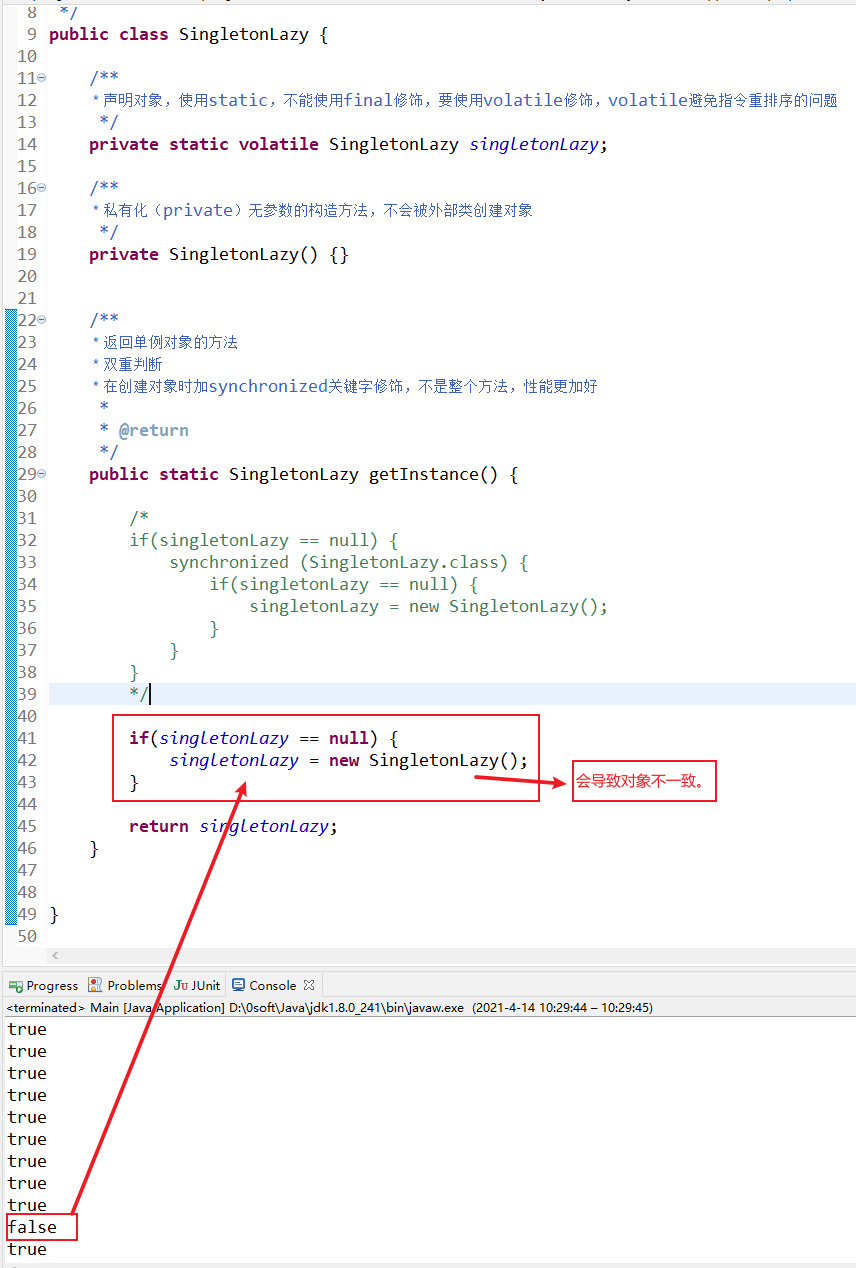Java 单例模式,Java Singleton单例模式
Java 单例模式,Java Singleton单例模式
================================
©Copyright 蕃薯耀 2021-04-14
https://www.cnblogs.com/fanshuyao/
一、单例模式 - 饿汉模式
* 单例模式-饿汉模式
* 优化:代码简单,线程安全
* 缺点:类初始化时,直接创建了对象,增加了内存的使用
/** * 单例模式-饿汉模式 * 优化:代码简单,线程安全 * 缺点:类初始化时,直接创建了对象,增加了内存的使用 * */ public class SingletonHungry { /** * 创建对象,使用static final修饰 */ private static final SingletonHungry singletonHungry = new SingletonHungry(); /** * 私有化(private)无参数的构造方法,不会被外部类创建对象 */ private SingletonHungry() {} /** * 返回单例对象的方法 * @return */ public static SingletonHungry getInstance() { return singletonHungry; } }
单例模式-饿汉模式测试代码:
public class Main { public static void singletonHungry() { for(int i=0; i<15; i++){ new Thread(()-> { System.out.println(SingletonHungry.getInstance() == SingletonHungry.getInstance()); }).start(); } } public static void main(String[] args) { singletonHungry(); } }
二、单例模式 - 懒汉模式 - 双重判断
* 单例模式-懒汉模式
* 优点:性能好,不直接创建对象,需要时才创建
* 缺点:双重判断,代码复杂
/** * 单例模式-懒汉模式 * 优点:性能好,不直接创建对象,需要时才创建 * 缺点:双重判断,代码复杂 * */ public class SingletonLazy { /** * 声明对象,使用static,不使用final修饰,要使用volatile修饰,volatile避免指令重排序的问题 */ private static volatile SingletonLazy singletonLazy; /** * 私有化(private)无参数的构造方法,不会被外部类创建对象 */ private SingletonLazy() {} /** * 返回单例对象的方法 * 双重判断 * 在创建对象时加synchronized关键字修饰,不是整个方法,性能更加好 * * @return */ public static SingletonLazy getInstance() { if(singletonLazy == null) { synchronized (SingletonLazy.class) { if(singletonLazy == null) { singletonLazy = new SingletonLazy(); } } } return singletonLazy; } }
测试代码:
public class Main { public static void singletonLazy() { for(int i=0; i<15; i++){ new Thread(()-> { System.out.println(SingletonLazy.getInstance() == SingletonLazy.getInstance()); }).start(); } } public static void main(String[] args) { singletonLazy(); } }
存在问题:
如果不使用双重判断和synchronized关键字修饰,会出问题:
public static SingletonLazy getInstance() { if(singletonLazy == null) { singletonLazy = new SingletonLazy(); } return singletonLazy; }
测试结果:存在 false
true true true true true true true true true false true true true true
true
如下图所示:


(时间宝贵,分享不易,捐赠回馈,^_^)
================================
©Copyright 蕃薯耀 2021-04-14
https://www.cnblogs.com/fanshuyao/
今天越懒,明天要做的事越多。




 浙公网安备 33010602011771号
浙公网安备 33010602011771号